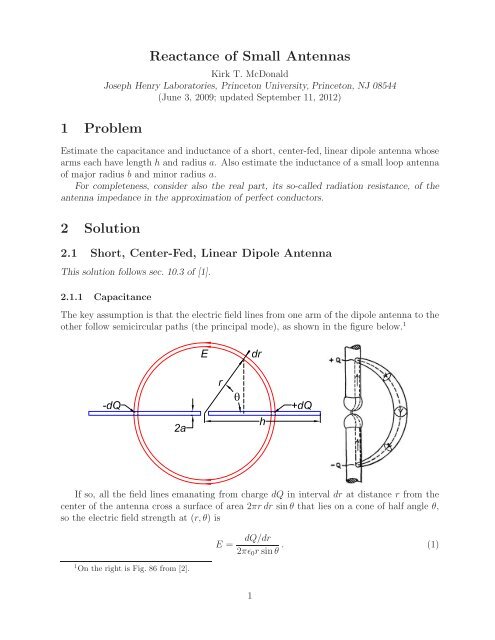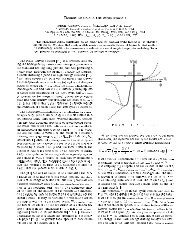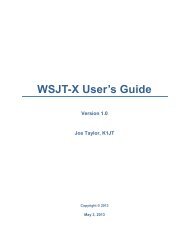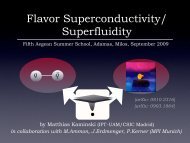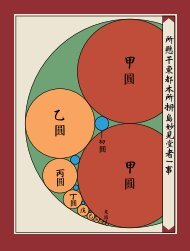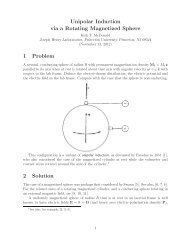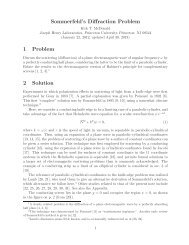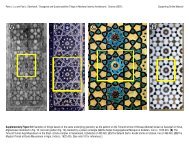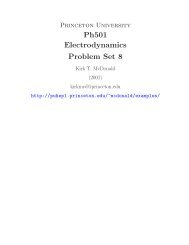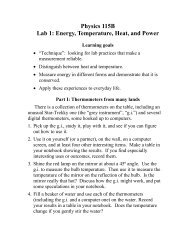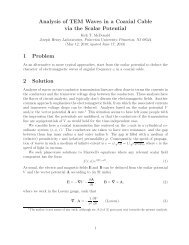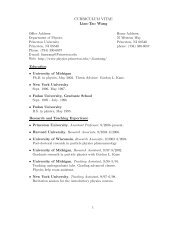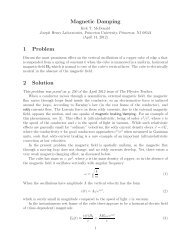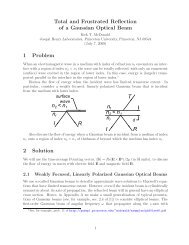Reactance of Small Antennas - Princeton University
Reactance of Small Antennas - Princeton University
Reactance of Small Antennas - Princeton University
You also want an ePaper? Increase the reach of your titles
YUMPU automatically turns print PDFs into web optimized ePapers that Google loves.
1 Problem<br />
<strong>Reactance</strong> <strong>of</strong> <strong>Small</strong> <strong>Antennas</strong><br />
Kirk T. McDonald<br />
Joseph Henry Laboratories, <strong>Princeton</strong> <strong>University</strong>, <strong>Princeton</strong>, NJ 08544<br />
(June 3, 2009; updated September 11, 2012)<br />
Estimate the capacitance and inductance <strong>of</strong> a short, center-fed, linear dipole antenna whose<br />
arms each have length h and radius a. Also estimate the inductance <strong>of</strong> a small loop antenna<br />
<strong>of</strong> major radius b and minor radius a.<br />
For completeness, consider also the real part, its so-called radiation resistance, <strong>of</strong> the<br />
antenna impedance in the approximation <strong>of</strong> perfect conductors.<br />
2 Solution<br />
2.1 Short, Center-Fed, Linear Dipole Antenna<br />
This solution follows sec. 10.3 <strong>of</strong> [1].<br />
2.1.1 Capacitance<br />
The key assumption is that the electric field lines from one arm <strong>of</strong> the dipole antenna to the<br />
other follow semicircular paths (the principal mode), as shown in the figure below. 1<br />
If so, all the field lines emanating from charge dQ in interval dr at distance r from the<br />
center <strong>of</strong> the antenna cross a surface <strong>of</strong> area 2πr dr sin θ that lies on a cone <strong>of</strong> half angle θ,<br />
so the electric field strength at (r, θ) is<br />
1 On the right is Fig. 86 from [2].<br />
E =<br />
dQ/dr<br />
2πɛ 0 r sin θ . (1)<br />
1
The voltage difference between the two arms <strong>of</strong> the antenna is 2<br />
∫ π/2<br />
ΔV =2 Er dθ = dQ/dr ∫ π/2 dθ<br />
θ min πɛ 0 a/r sin θ = dQ/dr ln[tan(θ/2)] π/2<br />
a/r<br />
πɛ = dQ/dr ln(2r/a). (2)<br />
0 πɛ 0<br />
This voltage difference should be independent <strong>of</strong> position along the antenna. 3 The charge<br />
distribution dQ/dr is indeed constant to a good approximation for short dipole antennas,<br />
but the factor ln(2r/a) =− ln(θ min /2) is constant only for a biconical dipole antenna (as<br />
much favored theoretically by Schelkun<strong>of</strong>f). A reasonable approximation for a linear dipole<br />
antenna is to use r = h/2 as a representative length in eq. (2), which leads to the estimate<br />
ΔV ≈ dQ/dr ln(h/a). (3)<br />
πɛ 0<br />
The corresponding capacitance per unit length along the antenna is<br />
dC<br />
dr ≈ πɛ 0<br />
ln(h/a) , (4)<br />
and the total capacitance is<br />
C ≈<br />
πɛ 0h<br />
ln(h/a) . (5)<br />
This estimate ignores the contribution to the capacitance <strong>of</strong> roughly πɛ 0 a 2 /d associated with<br />
the electric field in the gap d between the terminals <strong>of</strong> the antenna, as is reasonable when<br />
d ≈ a since then ln(h/a) ≪ h/a ≈ dh/a 2 .<br />
2.1.2 Inductance<br />
For a quick estimate <strong>of</strong> the inductance <strong>of</strong> the antenna we note when the arms carry current<br />
I the magnetic field near the conductors varies with distance as<br />
B ≈ μ 0I<br />
2πr . (6)<br />
The magnetic flux associated with the linear antenna is<br />
∫ h<br />
Φ=LI ≈ h Bdr≈ μ 0hI<br />
a 2π ln h a , (7)<br />
where we note that the current drops from I to0overlengthh <strong>of</strong> each arm. Then, our<br />
rough estimate <strong>of</strong> the inductance L is<br />
L ≈ μ 0h<br />
2π ln h a . (8)<br />
2 In general the electric field is related to the scalar and vector potentials by E = −∇V − ∂A/∂t =<br />
−∇V − iωA, assuming a time dependence <strong>of</strong> the form e iωt . Then, ∫ 2<br />
1 E · dl = V 1 − V 2 − iω ∫ 2<br />
1 A · dl.<br />
However, close to a small linear dipole antenna the electric field is much larger than the magnetic field (see,<br />
for example, [3]), and the contribution <strong>of</strong> the vector potential to the electric field in negligible in this region.<br />
3 The vanishing <strong>of</strong> the tangential component <strong>of</strong> the electric field along the (ideal) conductor implies that<br />
this conductor is an equipotential only if the vector potential can be neglected. For examples where this<br />
does not hold, see [4, 5].<br />
2
2.1.3 <strong>Reactance</strong><br />
The reactance <strong>of</strong> a short linear antenna (h ≪ λ) is largely due to its capacitance,<br />
X small linear = ωL − 1<br />
ωC ≈− 1<br />
ckC ≈−ln(h/a) πɛ 0 ckh = −Z 0 ln(h/a)<br />
π kh<br />
where (c =1/ √ ɛ 0 μ 0 being the speed <strong>of</strong> light in vacuum)<br />
√<br />
μ0<br />
Z 0 = = μ<br />
ɛ 0 c = 1<br />
0 ɛ 0 c<br />
= − Z 0<br />
π 2<br />
λ<br />
ln(h/a), (9)<br />
2h<br />
= 377 Ω. (10)<br />
The reactance (9) falls with increasing length h <strong>of</strong> the arms <strong>of</strong> the antenna, and vanishes<br />
when<br />
ω = √ 1<br />
√<br />
2π 1<br />
≈ LC μ 0 h πɛ 0 h = √ 2 c √<br />
2πc<br />
2λ<br />
= kc =<br />
h λ , i.e., h ≈ 2π = λ<br />
4.44 . (11)<br />
Thus, the rough estimates (5) and (8) <strong>of</strong> C and L for a linear antenna give a fairly good<br />
prediction <strong>of</strong> “resonance” when half-length h ≈ λ/4.<br />
2.1.4 Relation between <strong>Reactance</strong> and “Free Oscillation”<br />
As an aside, we note that frequencies at which the terminal reactance vanishes correspond<br />
to those <strong>of</strong> “free oscillation <strong>of</strong> the antenna (with its terminals shorted).<br />
In a “free oscillation” 4 radiation is ignored and the (near) fields are standing waves that<br />
obey the Helmholtz equation, (∇ 2 + k 2 )ψ =0,whereψ is any scalar component <strong>of</strong> the<br />
electric and magnetic fields. Electromagnetic energy is stored in the (near) fields, which<br />
oscillates between “electric” and “magnetic” terms, there being no exchange <strong>of</strong> energy with<br />
the perfect conductor.<br />
For driven oscillations <strong>of</strong> a conductor, a nonzero terminal reactance implies an exchange<br />
<strong>of</strong> energy between the energy/voltage source and the (near) electromagnetic fields.<br />
Thus, if the reactance in nonzero at some frequency, that frequency cannot correspond to<br />
a “free oscillation” (for which there is no exchange <strong>of</strong> energy between fields and conductors).<br />
2.2 <strong>Small</strong> Loop Antenna<br />
2.2.1 Inductance<br />
One definition <strong>of</strong> a small loop antenna is that the spatial variation <strong>of</strong> the current around the<br />
loop can be neglected. In this case the inductance is essentially that <strong>of</strong> a circular loop/torus<br />
<strong>of</strong>,say,majorradiusb and minor radius a, supposing that all the current in on the surface<br />
because <strong>of</strong> the skin effect.<br />
ForaquickestimatewenotewhentheloopcarriescurrentI the magnetic field near the<br />
conductor varies with distance as<br />
B ≈ μ 0I<br />
2πr , (12)<br />
4 “Free oscillations” <strong>of</strong> (perfect) conductors were perhaps first discussed in [6]. See also, [7].<br />
3
so the magnetic flux linked by the loop is<br />
and the inductance L is<br />
∫ b<br />
Φ=LI ≈ 2πb Bdr≈ μ 0 bI ln b<br />
a<br />
a , (13)<br />
L ≈ μ 0 b ln b (<br />
a = μ 0b ln 8b )<br />
a − 2.08 . (14)<br />
A more exact calculation using toroidal coordinates [8] shows that the number 2.08 = ln 8<br />
in eq. (14) is actually 2 when b ≫ a.<br />
2.2.2 Capacitance<br />
A loop antenna has a small capacitance C associated with the gap between its terminal.<br />
However, the capacitive reactance 1/iωC is negligible in practice, so we skip estimating the<br />
capacitance C. 5<br />
2.2.3 <strong>Reactance</strong><br />
The reactance <strong>of</strong> a small loop antenna is essentially that due to its inductance,<br />
X small loop ≈ ωL ≈ μ 0 ωb ln b a = μ 0ckb ln b a = Z 2πb<br />
0<br />
λ ln b a . (15)<br />
A<br />
Appendix: Radiation Resistance <strong>of</strong> <strong>Small</strong> <strong>Antennas</strong><br />
For completeness, we include the well-known calculations <strong>of</strong> the radiation resistance R rad <strong>of</strong><br />
small antennas, noting that the time-average radiated power P is related to the peak current<br />
I 0 at the antenna terminals by<br />
P = I 2 0R rad<br />
2<br />
= μ 0 |¨p| 2<br />
12πc = μ 0 ω 4 |p 0 | 2<br />
, i.e., R rad = μ 0 ω 4 |p 0 | 2<br />
, (16)<br />
12πc<br />
6πcI0<br />
2<br />
where p 0 is the peak electric dipole moment <strong>of</strong> the antenna (or p 0 = m 0 /c in case the antenna<br />
has magnetic dipole moment m).<br />
A.1 Short Linear Antenna<br />
A linear antenna (<strong>of</strong> half length h, alongthez-axis) has electric dipole moment p related to<br />
its linear charge density ρ by<br />
∫ h<br />
p = ρz dz. (17)<br />
−h<br />
5 An estimate <strong>of</strong> the terminal capacitance is given as a/2 in eq. (5) <strong>of</strong> [9]. A very different estimate is<br />
given in sec. 10-12 <strong>of</strong> [1], assuming that it is meaningful to consider the loop to be a capacitor consisting<br />
<strong>of</strong> two half loops; however, the current around a small loop is uniform, so there is no charge distribution<br />
around the loop, except at the terminals, and the estimate <strong>of</strong> [1] seems inappropriate.<br />
4
The charge density is related to the current distribution<br />
I(z,t) ≈ I 0 (1 −|z| /h) e iωt , (18)<br />
by the continuity equation,<br />
˙ρ = − dI<br />
dz ≈±I 0<br />
h eiωt , (19)<br />
so that<br />
ρ = ∓ iI 0<br />
ωh eiωt , (20)<br />
and<br />
p 0 = − iI 0h<br />
(21)<br />
ω<br />
from eq. (17). Then, according to eq. (16) the radiation resistance is, recalling eq. (10),<br />
R rad = μ 0 ω 4 |p 0 | 2<br />
6πcI 2 0<br />
= μ 0 ω 2 h 2<br />
6πc<br />
= πμ 0 c (2h) 2<br />
6<br />
= πZ 0<br />
6<br />
(2h) 2<br />
λ 2 . (22)<br />
The approximation (19) is not very accurate for “resonance” with h ≈ λ/4, for which<br />
eq. (22) gives R rad,resonance ≈ 377π/24 = 49 Ω rather than 71 Ω.<br />
For an (“unmatched”) small linear antenna with terminal impedance Z ≈ iX and reactance<br />
X given by eq. (9), the time-average radiated power when driven by a voltage source<br />
V 0 is, noting that I 0 = |V 0 /Z|,<br />
P linear,unmatched = V 0 2R<br />
rad<br />
2 |Z| 2 ≈ V 2<br />
2X 2<br />
0 R rad<br />
≈<br />
π 5 V0<br />
2 (2h) 4<br />
12Z 0 ln 2 (h/a) λ 4 . (23)<br />
If the small linear antenna is “matched” to a line <strong>of</strong> (real) impedance Z line (≫ R rad )then<br />
P linear,matched = V 2<br />
0 R rad<br />
2Z 2 line<br />
≈ πV 0 2Z<br />
0 (2h) 2<br />
12Zline<br />
2 λ 2 . (24)<br />
A.2 <strong>Small</strong> Loop Antenna<br />
A small loop antenna (<strong>of</strong> radius b) has azimuthally symmetric current I(φ, t) =I 0 e −iωt ,such<br />
that the peak magnetic dipole moment is<br />
and radiation resistance<br />
m 0 = πb 2 I 0 , (25)<br />
R rad = μ 0ω 4 |m 0 | 2<br />
= πμ 0ω 4 b 4<br />
= πμ 0c (2πb) 4<br />
6πc 3 I0<br />
2 6c 3 6 λ 4 = πZ 0 (2πb) 4<br />
6 λ 4 . (26)<br />
For an (“unmatched”) small loop antenna with reactance X given by eq. (15) the timeaverage<br />
radiated power when driven by a voltage source V 0 is<br />
P loop,unmatched ≈ V 2<br />
0 R rad<br />
2X 2<br />
5<br />
≈<br />
πV0<br />
2 (2πb) 2<br />
12Z 0 ln 2 (b/a) λ 2 . (27)
If the small loop antenna is “matched” to a line <strong>of</strong> impedance Z line then<br />
P loop,matched = V 2<br />
0 R rad<br />
2Z 2 line<br />
≈ πV 0 2 Z 0 (2πb) 4<br />
12Zline<br />
2 λ 4 . (28)<br />
Thus, a “matched,” small loop antenna <strong>of</strong> circumference 2πb radiates much less power than<br />
a “matched,” small linear antenna <strong>of</strong> total length 2h =2πb. 6<br />
References<br />
[1] S.A. Schelkun<strong>of</strong>f and H.T. Friis, <strong>Antennas</strong>, Theory and Practice (Wiley, New York,<br />
1952),<br />
http://puhep1.princeton.edu/~mcdonald/examples/EM/schelkun<strong>of</strong>f_friis_antennas_c10.pdf<br />
[2] H. Poincaré and F.K. Vreeland, Maxwell’s Theory and Wireless Telegraphy (McGraw,<br />
New York, 1904),<br />
http://puhep1.princeton.edu/~mcdonald/examples/EM/poincare_vreeland_04.pdf<br />
[3] K.T. McDonald, Radiation in the Near Zone <strong>of</strong> a Hertzian Dipole (April 22, 2004),<br />
http://puhep1.princeton.edu/~mcdonald/examples/nearzone.pdf<br />
[4] K.T. McDonald, What Does an AC Voltmeter Measure? (March 16, 2008),<br />
http://puhep1.princeton.edu/~mcdonald/examples/voltage.pdf<br />
[5] K.T. McDonald, Lewin’s Circuit Paradox (May 7, 2010),<br />
http://puhep1.princeton.edu/~mcdonald/examples/lewin.pdf<br />
[6] M. Abraham, Die electrischen Schwingungen um einem stabförmigen Leiter, behandelt<br />
nach der Maxwell’schen Theorie, Ann. Phys. 66, 435 (1898),<br />
http://puhep1.princeton.edu/~mcdonald/examples/EM/abraham_ap_66_435_98.pdf<br />
[7] Lord Rayleigh, On the Electrical Vibrations associated with thin terminated Conducting<br />
Rods, Phil. Mag. 8, 104 (1904),<br />
http://puhep1.princeton.edu/~mcdonald/examples/EM/rayleigh_pm_8_105_04.pdf<br />
[8] V. Fock, Skin-Effekt in einem Ringe, Phys.Zeit.Sow.U.1, 215 (1932),<br />
http://puhep1.princeton.edu/~mcdonald/examples/EM/fock_phys_z_sow_u_1_215_32.pdf<br />
[9] K.T. McDonald, Radiation by an AC Voltage Source (Jan. 9, 2005),<br />
http://puhep1.princeton.edu/~mcdonald/examples/acsource.pdf<br />
6 An “unmatched,” small loop antenna <strong>of</strong> circumference 2πb radiates more power than an “unmatched,”<br />
small linear antenna <strong>of</strong> total length 2h =2πb provided 2πb < ∼ λ/10, but the radiated power is quite small.<br />
6


